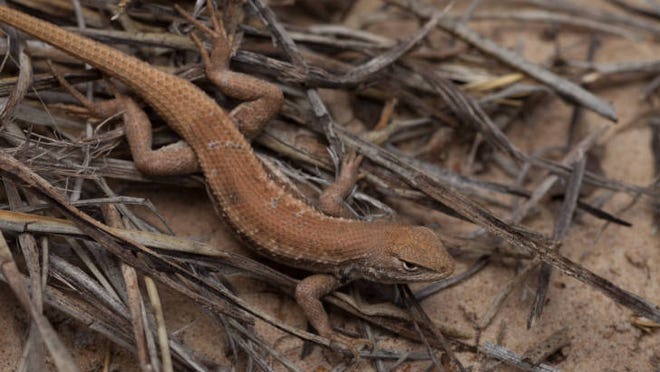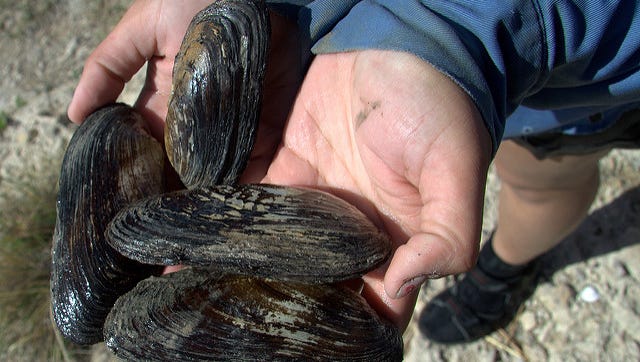
Alisa Ogden worried a small river mussel could impede her ranching operations in southern Eddy County near the Village of Loving.
Her land sits along the Black River, one of the last known habitats of Texas hornshell mussel which the federal government is working to conserve from extinction.
Ogden said her family worked the land since 1890, and long took steps to prevent damage to the land and nearby ecosystems, work that continued today successfully without federal action as the U.S. Fish and Wildlife Service proposed a critical habitat listing for the mussel.
More:Access to New Mexico rivers could be restricted to protect Texas hornshell mussel
“This type of declaration is a slap in the face of all the measures which we have voluntarily implemented so far,” Ogden said. “Declaring critical habitat does not make for more collaboration.”
She said efforts were taken to spread out cattle to avoid damages from excessive grazing and other impacts to the river by building erosion control structures, fences, and water troughs away from the river along with brush control.
“Long before the mussel was designated threatened or declared endangered, we have strived to improve the pasture along the river as well as the pasture lands on the drainages leading into the river, no matter if the surface was private property or federal property,” she said.
“All of these measures helped to decrease sediment, improve water quality flowing into the river when rain occurs and keep banks of the rivers in healthy slopes rather than steep banks.”
More:Feds hope nearly-extinct desert ferret could return to New Mexico, American West

Landowners and other stakeholders like Ogden in southeast New Mexico voiced concerns that a federal decision aimed to protect the Texas hornshell mussel could restrict access to local rivers and waterways in the Carlsbad area.
The U.S. Fish and Wildlife Service on June 10 proposed a critical habitat designation for the hornshell on numerous rivers throughout New Mexico and Texas including the Black and Delaware rivers south of Carlsbad.
Both of those rivers are tributaries of the Pecos River which flows from northern New Mexico, through the southeast corner of the state and into Texas, and provides water to local ranchers, landowners and for other activities like oil and gas development.
More:Rebuilding the river: Pecos River conservation projects awarded $1.5 million in grant funds.
A public comment period was opened by the Service until Aug. 9 for stakeholders to provide input, and a final ruling was scheduled for June 10, 2022.
The hornshell, New Mexico’s last remaining native mussel species was imperiled in recent years by development throughout its range and its population today was reported as a small fraction of historic numbers.
In 2018, the Fish and Wildlife Service opted to list the mussel as endangered which required a recovery plan be implemented and could include deemed certain areas as “critical habitat” to impose additional restrictions not only on activities that could threaten the animal itself but also areas where it could dwell in the future.
More:Jaguars could be reintroduced in New Mexico as conservationists fight to save the cat
During a June 29 public hearing, freshwater mussel biologist with the U.S. Fish and Wildlife Service Gary Pandolfi said the lands proposed as critical habitat were determined to be important to the conservation of the hornshell mussel, and that any federal agency taking action on the lands, if the designation is approved, must first consult with the U.S. Fish and Wildlife Service.
“Designating critical habitat does not affect land ownership or establish a refuge, wilderness area, reserve, preserve or other conservation area,” he said. “Critical habitat designations affect only federal agency actions or federally funded or permitted activities.”
While the species was listed as endangered on March 12, 2018, Pandolfi said critical habitat was not yet protected.
More:Yellow-billed cuckoo gains habitat protections in New Mexico, other states in Western U.S.
The proposal included five units for protection: 113 miles of the Rio Grande in the Lower Canyons area, 190 miles of the Rio Grande in the Laredo Area, 9.7 miles of the Black River, 31 miles of the Delaware River and 33 miles of Devils River.
The Delaware and Black river units were the only areas in New Mexico proposed, both in Eddy County. The rest were in West Texas.
“These are population centers. These are areas where the Service and others can reliably and predictably find Texas hornshell,” Pandolfi said. “That doesn’t mean that there couldn’t be individuals outside of these areas.”
More:Federal judge orders rare New Mexico fish species could be listed as endangered
The Service announced in its initial critical habitat proposal that it could exclude the Black and Delaware rivers from the listing due to ongoing conservation efforts in the region, taking the form of candidate conservation agreements (CCAs) on federal land and candidate conservation agreements with assurances (CCAAs) on state and private land.
These agreements, certified by the Service, see landowners agreeing to practices aimed at conserving the species ahead of the listing, and can prevent future restrictions should a listing be enacted.
The CCAs and CCAAs were facilitated by Carlsbad-based conservation organization CEHMM also known as the Center for Excellence.
More:‘It’s our place to take care of them’: New Mexico landowners fight to save lesser prairie chicken
CEHMM Executive Director Emily Wirth said in June the Center was developing a habitat conservation plan, which could act as a post-listing option for landowners to avoid restrictions via agreed-upon conservation efforts.
“It’s collaborative conservation where we’ve got industry and ranchers and other groups together so we can see work continue on the land while still conserving the species,” she said.
“Fish and Wildlife Service is proposing to exclude the Black and Delaware rivers due to those conservation agreements. I think it is very important for people to comment in support of that exclusion.”
Alessandra Papa, representing environmental group Environment Texas said the federal designation was needed for all portions of the Rio Grande and its tributaries as proposed initially, and the Service should consider expanding the critical habitat to areas uninhabited by the mussel that it could use to expand its range.
She said species listed under the Endangered Species Act with critical habitat designations were twice as likely to recover.
“Hornshells depend on unpolluted waters and fish to live and pollution, water depletion and dam construction are all contributing to the decline of Texas hornshells,” Papa said.
“Designating these areas as critical habitat is the best way to ensure federal actions don’t harm the areas that hornshells need to recover as an endangered species.”
Adrian Hedden can be reached at 575-618-7631, achedden@currentargus.com or @AdrianHedden on Twitter.






